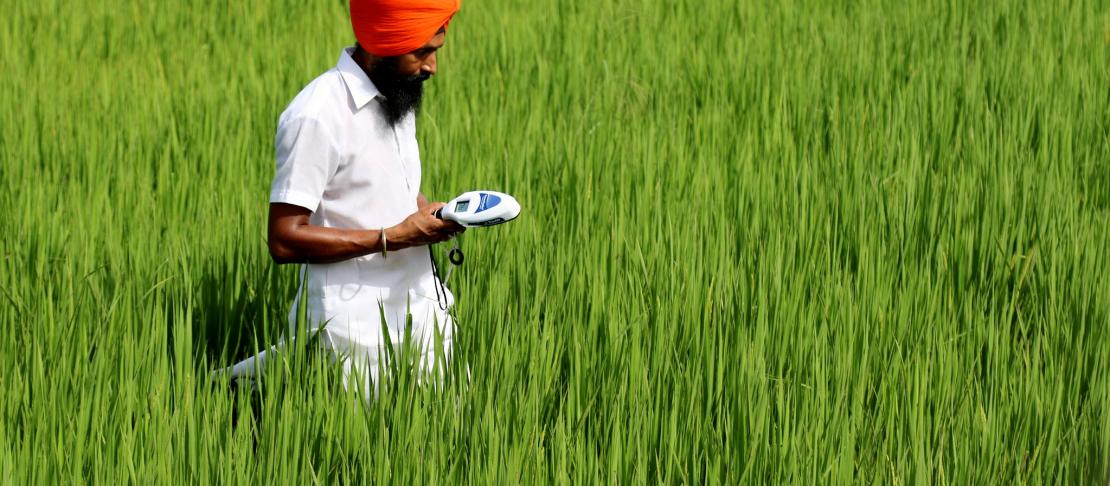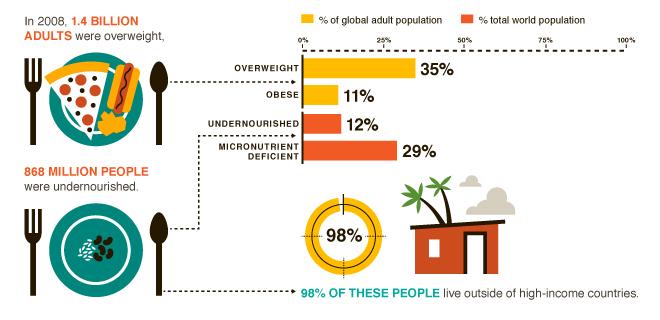
CCAFS uses the concept of climate-smart agriculture to structure its approach to climate-responsive options.
Climate-smart agriculture (CSA) is an integrative approach to address these interlinked challenges of food security and climate change, that explicitly aims for three objectives:
- Sustainably increasing agricultural productivity, to support equitable increases in farm incomes, food security and development;
- Adapting and building resilience of agricultural and food security systems to climate change at multiple levels; and
- Reducing greenhouse gas emissions from agriculture (including crops, livestock and fisheries).
Key characteristics of CSA
CSA addresses climate change
Contrary to conventional agricultural development, CSA systematically integrates climate change into the planning and development of sustainable agricultural systems.
CSA integrates multiple goals and manages trade-offs
Ideally, CSA produces triple-win outcomes: increased productivity, enhanced resilience and reduced emissions. But often it is not possible to achieve all three. Frequently, when it comes time to implement CSA, trade-offs must be made. This requires us to identify synergies and weigh the costs and benefits of different options based on stakeholder objectives identified through participatory approaches.
CSA maintains ecosystems services
Ecosystems provide farmers with essential services, including clean air, water, food and materials. It is imperative that CSA interventions do not contribute to their degradation. Thus, CSA adopts a landscape approach that builds upon the principles of sustainable agriculture but goes beyond the narrow sectoral approaches that result in uncoordinated and competing land uses, to integrated planning and management.
CSA has multiple entry points at different levels
CSA should not be perceived as a set of practices and technologies. It has multiple entry points, ranging from the development of technologies and practices to the elaboration of climate change models and scenarios, information technologies, insurance schemes, value chains and the strengthening of institutional and political enabling environments. As such, it goes beyond single technologies at the farm level and includes the integration of multiple interventions at the food system, landscape, value chain or policy level.
CSA is context-specific
What is climate-smart in one-place may not be climate-smart in another, and no interventions are climate-smart everywhere or every time. Interventions must take into account how different elements interact at the landscape level, within or among ecosystems and as a part of different institutional arrangements and political realities. The fact that CSA often strives to reach multiple objectives at the system level makes it particularly difficult to transfer experiences from one context to another.
CSA engages women and marginalised groups
To achieve food security goals and enhance resilience, CSA approaches must involve the poorest and most vulnerable groups. These groups often live on marginal lands which are most vulnerable to climate events like drought and floods. They are, thus, most likely to be affected by climate change. Gender is another central aspect of CSA. Women typically have less access and legal right to the land which they farm, or to other productive and economic resources which could help build their adaptive capacity to cope with events like droughts and floods (Huyer et al. 2015). 6 CSA strives to involve all local, regional and national stakeholders in decision-making. Only by doing so, is it possible to identify the most appropriate interventions and form the partnerships and alliances needed to enable sustainable development.
Why climate-smart agriculture?
Climate-smart agriculture (CSA) helps address a number of important challenges:
CSA addresses food security, misdistribution and malnutrition
Despite the attention paid to agricultural development and food security over the past decades, there are still about 800 million undernourished and 1 billion malnourished people in the world. At the same time, more than 1.4 billion adults are overweight and one third of all food produced is wasted. Before 2050, the global population is expected to swell to more than 9.7 billion people. At the same time, global food consumption trends are changing drastically, for example, increasing affluence is driving demand for meat-rich diets. If the current trends in consumption patterns and food waste continue, it is estimated we will require 60% more food production by 2050. CSA helps to improve food security for the poor and marginalised groups while also reducing food waste globally.

Source: CCAFS Big Facts: Food security
CSA addresses the relationship between agriculture and poverty
Agriculture continues to be the main source of food, employment and income for many people living in developing countries. Indeed, it is estimated that about 75% of the world’s poor live in rural areas, with agriculture being their most important income source. As such, agriculture is uniquely placed to propel people out of poverty. Agricultural growth is often the most effective and equitable strategy for both reducing poverty and increasing food security.
CSA addresses the relation between climate change and agriculture
Climate change is already increasing average temperatures around the globe and, in the future, temperatures are projected to be not only hotter but more volatile too. This, in turn, will alter how much precipitation falls, where and when. Combined, these changes will increase the frequency and intensity of extreme weather events such as hurricanes, floods, heat waves, snowstorms and droughts. They may cause sea level rise and salinization, as well as perturbations across entire ecosystems. All of these changes will have profound impacts on agriculture, forestry and fisheries.
The agriculture sector is particularly vulnerable to climate change because different crops and animals thrive in different conditions. This makes agriculture highly dependent on consistent temperature ranges and water availability, which are exactly what climate change threatens to undermine. In addition, plant pests and diseases will likely increase in incidence and spread into new territories bringing further challenges for agricultural productivity.
While climate change will have both positive and negative impacts on crop yields - meaning that for some crops in some areas, yields will rise while others elsewhere suffer - negative impacts have outweighed positive impacts to date. Already, it is estimated that climate change has reduced global yields of wheat by 5.5% and of maize by 3.8%. By 2090, it is projected that climate change will result in an 8-24% loss of total global caloric production from maize, soy, wheat and rice. Where these declines in productivity occur will vary. For example, sub-Saharan Africa will be hit particular hard; it is estimated that across Africa maize yields will drop by 5% and wheat yields by 17% before 2050.
The relationship between agriculture and climate change is a two-way street: agriculture is not only affected by climate change but has a significant effect on it in return. Globally, agriculture, land-use change and forestry are responsible for 19-29% of greenhouse gas (GHG) emissions. Within the least developed countries, this figure rises to 74%. If agricultural emissions are not reduced, agriculture will account for 70% of the total GHG emissions that can be released if temperature increases are to be limited to 2°C. The mitigation options available within the agricultural sector are just as cost-competitive as those established within the energy, transportation and forestry sectors. And they are just as capable of achieving long-term climate objectives. For this reason, mitigation is one of the three pillars of climate-smart agriculture.
How is CSA different from other sustainable agriculture approaches?
In the twentieth century, significant increases in agricultural productivity were achieved under the banner of the so-called 'Green Revolution'. Through monocropping and an increased use of pesticides and fertilizers, crop yields around the world steadily rose. This progress, however, was made at a significant cost. Soil qualities were degraded, biodiversity reduced and pest resistance diminished. At the same time, increased pesticide and fertilizer pollution in soils and groundwater put both the environment and human health at risk.
Climate-smart agriculture (CSA) is not yet another reincarnation of the ‘Green Revolution’. To the contrary, CSA has much in common with sustainable agricultural approaches. This means that addressing climate change does not require us to discard or reinvent everything that has been learned about agriculture and sustainable development in recent decades. In fact, CSA is built upon a technical foundation that largely already exists and a range of sustainable agricultural approaches—such as sustainable agriculture, sustainable intensification and conservation agriculture—are the cornerstones of implementing CSA in practice.
So how does CSA differ from sustainable agriculture? This boils down to three essential features: (i) an explicit focus on climate change; (ii) the search for synergies and negotiation of trade-offs in the pursuit of productivity, adaptation and mitigation outcomes in a broader landscape or system perspective; and (iii) the availability of new funding opportunities for agricultural development.
The three big differences:
A focus on climate change:
Like other sustainable agricultural approaches, CSA is based on principles of increased productivity and sustainability. But it is distinguished by a focus on climate change, explicitly addressing adaptation and mitigation challenges while working towards food security for all. In essence, CSA is sustainable agriculture that incorporates resilience concerns while at the same time seeking to reduce greenhouse gas emissions. CSA = Sustainable Agriculture + Resilience – Emissions.
Outcomes, synergies and trade-offs
To develop interventions that simultaneously meet the three challenges of productivity, adaptation and mitigation, CSA must not only focus on technologies and practices, but also on the outcomes of interventions beyond the farm level. In doing so, it must consider the synergies and trade-offs that exist between productivity, adaptation and mitigation, as well as the interactions that occur at different levels including wider socio-ecological implications. For instance, CSA interventions at the farm/community level may affect both the social and ecological systems in place, as well as the wider landscape. Likewise, a CSA intervention that aims to increase productivity should also consider how it affects adaptation and mitigation, and how it can best optimize all three outcomes at the most appropriate level. All of this requires farmers and decision-makers to understand the synergies and trade-offs that exist between the three pillars and between different levels. To help people make informed decisions—from the farm to parliament—CSA focuses on developing metrics and prioritization tools that bring these synergies and trade-offs to the fore.
New funding opportunities
Currently, there is an enormous deficit in the investment that is required to meet food security. By explicitly focusing on climate change, CSA opens up new funding opportunities for agricultural development, by allowing the sector to tap into climate finance for adaptation and mitigation. This includes funding from, among others, the Adaptation Fund, the Least Developed Countries Fund or the Special Climate Fund, as well as the Clean Development Mechanism and the Voluntary Carbon Market. Most promising of all is the earmarked allocation which has been made specifically for CSA by the Global Environment Facility Trust Fund (GEF) and the future Green Climate Fund.